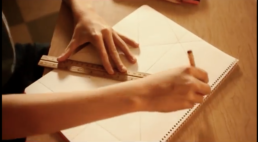
For students studying geometry at the Susquehanna Waldorf School, precision is compatible with beauty. Each student’s lesson book not only illustrates their knowledge and understanding, but also showcases their individual creativity and personality as they add their own color and shading to their construction. The result is a classroom brimming with richly colored and rigorously made shapes, integrally tied to mathematical understanding.
“We want the students to understand visually how the formulas work, not just memorize the formulas,” explains Leilani Richardson, Grade 6 teacher. As early as Grade 2, students begin laying the groundwork for geometry by creating form drawings and exploring multiplication through a circular times table. This advances to connecting points on a page with a ruler, and goes on to yield an exponentially broader range of form and color as students learn to bisect lines and angles. The technical terminology advances with the drawings, introducing the names of angles, line segments, and concepts. By the time the students reach the higher grades, they are well prepared for the rigor of constructing complex shapes and grasping advanced theories.
Constructing the shapes in the higher classes takes an enormous amount of focus and self-discipline. Pedagogically, this touches on a key aspect of the students’ development. “At this age, their bodies and their inner world are askew. They are growing and changing so rapidly, and the work to create these geometric drawings brings order and focus to their thinking. It is very comforting to them,” says Richardson. Students are also given an opportunity for self-discovery and self-direction. In one exercise, students are asked to determine the area of a triangle with just a square of paper. Not only does this encourage the student to find the connection independently, but it also gives them an opportunity to clearly express their discovery in words and in a mathematical language.
Beginning in the early grades as simple form drawings and progressing into the higher classes as meticulously constructed shapes, geometry in the Waldorf curriculum goes beyond the calculations and formulations to get at the very essence of shapes. It is a development of mathematical thinking that creates an understanding of the whole to the parts, and connects its students to the source.
